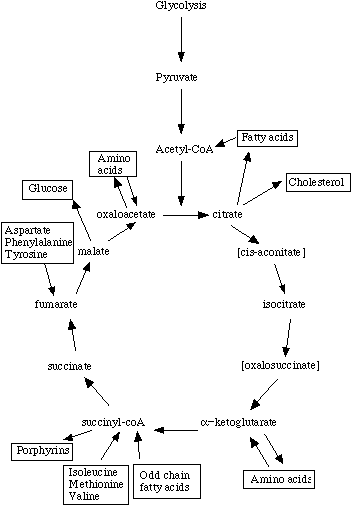
(a) Give a schematic representation of Krebs cycle. List the enzymes involved in each step.
(b) Mention the steps in Krebs cycle in which step NAD and FAD are reduced by accepting hydrogen from different substrates.
Answer
510.1k+ views
Hint: Krebs’s cycle is the process that takes place after the glycolysis or EMP pathway. This process consists of many chemical reactions that convert glucose into the energy. This process is also known as citric acid cycle or tricarboxylic acid.
Complete step by step answer:

Step involved in the Krebs cycle
(1) The condensation takes place. Acetyl group is converted into the citric acid by the reaction with water and fatty acids. The enzyme citrate synthase is used for the catalyzation.
(2) The citric acid obtained from the previous step is converted into isocitrate
(3) Then the next two process is the decarboxylation which yield ketoglutaric acid and succinyl-coA
(4) The succinyl-coA converts into succinic acid in which one molecule of GTP is produced.
(5) In the next reaction ATP is produced from the ADP and NAD is reduced to NADH and FAD is reduced to FADH.
(6) Then the acetic acid is converted to oxaloacetate which is again converted into citrate and hence the process is repeated.
(a) The enzymes involved in the Krebs cycle are citrate synthase, Aconitase, isocitrate dehydrogenase, ketoglutarate dehydrogenase, succinyl coenzyme A synthetase, succinate dehydrogenase, fumarase and malate dehydrogenase.
(b) In the third step of the citric acid cycle in which the citrate is converted to ketoglutarate, NAD is reduced to NADH. And in the fourth step where ketoglutarate is converted into succinyl-coA in which FAD is reduced to FADH. In the last step of the Krebs’s cycle NAD is converted into NADH.
So, the correct answer is “Option B”.
Note:
This Krebs’s cycle or citric acid cycle takes place two times for each molecule of the glucose and it is the cycle of closed loop. In eukaryotes it takes place in mitochondria where in prokaryotes it takes place in the cytoplasm of the cell.
Complete step by step answer:

Step involved in the Krebs cycle
(1) The condensation takes place. Acetyl group is converted into the citric acid by the reaction with water and fatty acids. The enzyme citrate synthase is used for the catalyzation.
(2) The citric acid obtained from the previous step is converted into isocitrate
(3) Then the next two process is the decarboxylation which yield ketoglutaric acid and succinyl-coA
(4) The succinyl-coA converts into succinic acid in which one molecule of GTP is produced.
(5) In the next reaction ATP is produced from the ADP and NAD is reduced to NADH and FAD is reduced to FADH.
(6) Then the acetic acid is converted to oxaloacetate which is again converted into citrate and hence the process is repeated.
(a) The enzymes involved in the Krebs cycle are citrate synthase, Aconitase, isocitrate dehydrogenase, ketoglutarate dehydrogenase, succinyl coenzyme A synthetase, succinate dehydrogenase, fumarase and malate dehydrogenase.
(b) In the third step of the citric acid cycle in which the citrate is converted to ketoglutarate, NAD is reduced to NADH. And in the fourth step where ketoglutarate is converted into succinyl-coA in which FAD is reduced to FADH. In the last step of the Krebs’s cycle NAD is converted into NADH.
So, the correct answer is “Option B”.
Note:
This Krebs’s cycle or citric acid cycle takes place two times for each molecule of the glucose and it is the cycle of closed loop. In eukaryotes it takes place in mitochondria where in prokaryotes it takes place in the cytoplasm of the cell.
Recently Updated Pages
Why are manures considered better than fertilizers class 11 biology CBSE

Find the coordinates of the midpoint of the line segment class 11 maths CBSE

Distinguish between static friction limiting friction class 11 physics CBSE

The Chairman of the constituent Assembly was A Jawaharlal class 11 social science CBSE

The first National Commission on Labour NCL submitted class 11 social science CBSE

Number of all subshell of n + l 7 is A 4 B 5 C 6 D class 11 chemistry CBSE

Trending doubts
10 examples of friction in our daily life

One Metric ton is equal to kg A 10000 B 1000 C 100 class 11 physics CBSE

Difference Between Prokaryotic Cells and Eukaryotic Cells

1 Quintal is equal to a 110 kg b 10 kg c 100kg d 1000 class 11 physics CBSE

State the laws of reflection of light

Explain zero factorial class 11 maths CBSE




